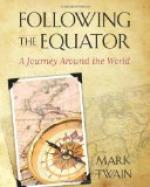The narrow inlets which I have mentioned go wandering out into the land everywhere and hiding themselves in it, and pleasure-launches are always exploring them with picnic parties on board. It is said by trustworthy people that if you explore them all you will find that you have covered 700 miles of water passage. But there are liars everywhere this year, and they will double that when their works are in good going order. October was close at hand, spring was come. It was really spring —everybody said so; but you could have sold it for summer in Canada, and nobody would have suspected. It was the very weather that makes our home summers the perfection of climatic luxury; I mean, when you are out in the wood or by the sea. But these people said it was cool, now—a person ought to see Sydney in the summer time if he wanted to know what warm weather is; and he ought to go north ten or fifteen hundred miles if he wanted to know what hot weather is. They said that away up there toward the equator the hens laid fried eggs. Sydney is the place to go to get information about other people’s climates. It seems to me that the occupation of Unbiased Traveler Seeking Information is the pleasantest and most irresponsible trade there is. The traveler can always find out anything he wants to, merely by asking. He can get at all the facts, and more. Everybody helps him, nobody hinders him. Anybody who has an old fact in stock that is no longer negotiable in the domestic market will let him have it at his own price. An accumulation of such goods is easily and quickly made. They cost almost nothing and they bring par in the foreign market. Travelers who come to America always freight up with the same old nursery tales that their predecessors selected, and they carry them back and always work them off without any trouble in the home market.
If the climates of the world were determined by parallels of latitude, then we could know a place’s climate by its position on the map; and so we should know that the climate of Sydney was the counterpart of the climate of Columbia, S. C., and of Little Rock, Arkansas, since Sydney is about the same distance south of the equator that those other towns are north of-it-thirty-four degrees. But no, climate disregards the parallels of latitude. In Arkansas they have a winter; in Sydney they have the name of it, but not the thing itself. I have seen the ice in the Mississippi floating past the mouth of the Arkansas river; and at Memphis, but a little way above, the Mississippi has been frozen over, from bank to bank. But they have never had a cold spell in Sydney which brought the mercury down to freezing point. Once in a mid-winter day there, in the month of July, the mercury went down to 36 deg., and that remains the memorable “cold day” in the history of the town. No doubt Little Rock has seen it below zero. Once, in Sydney, in mid-summer, about New Year’s Day, the mercury went up to 106 deg. in the shade,




